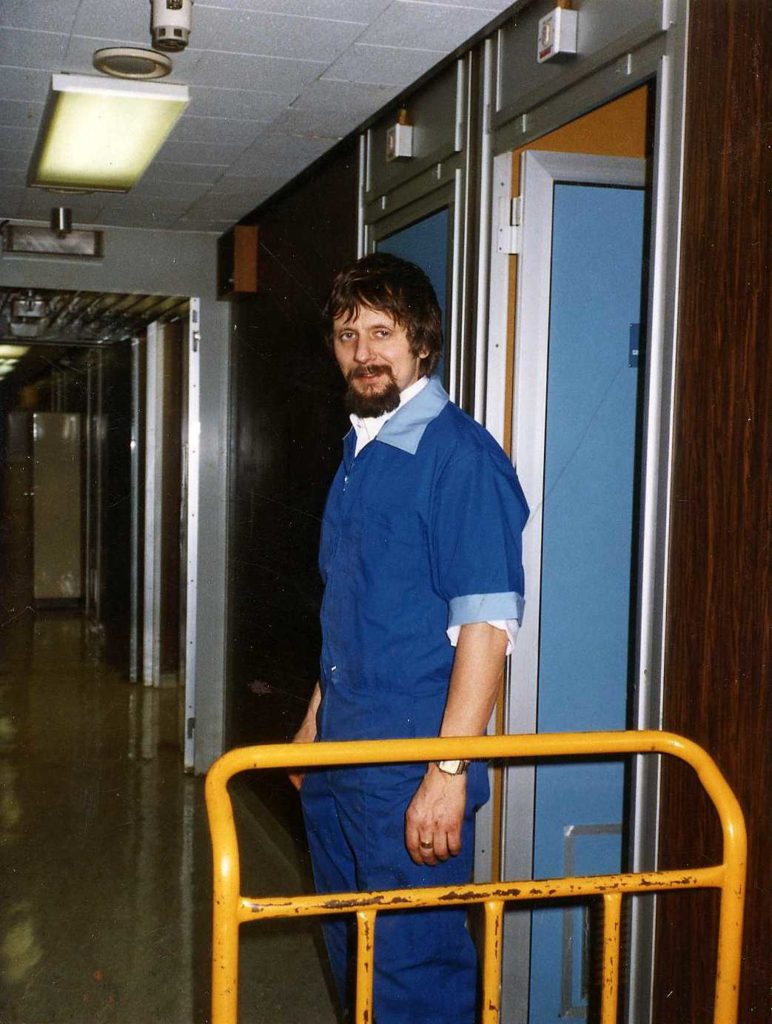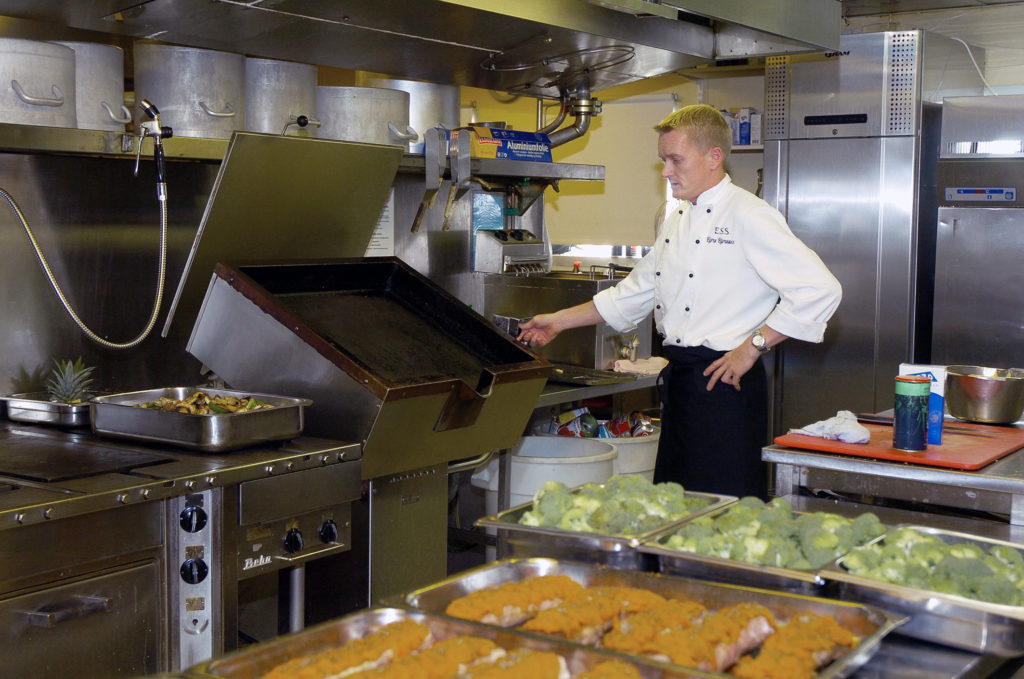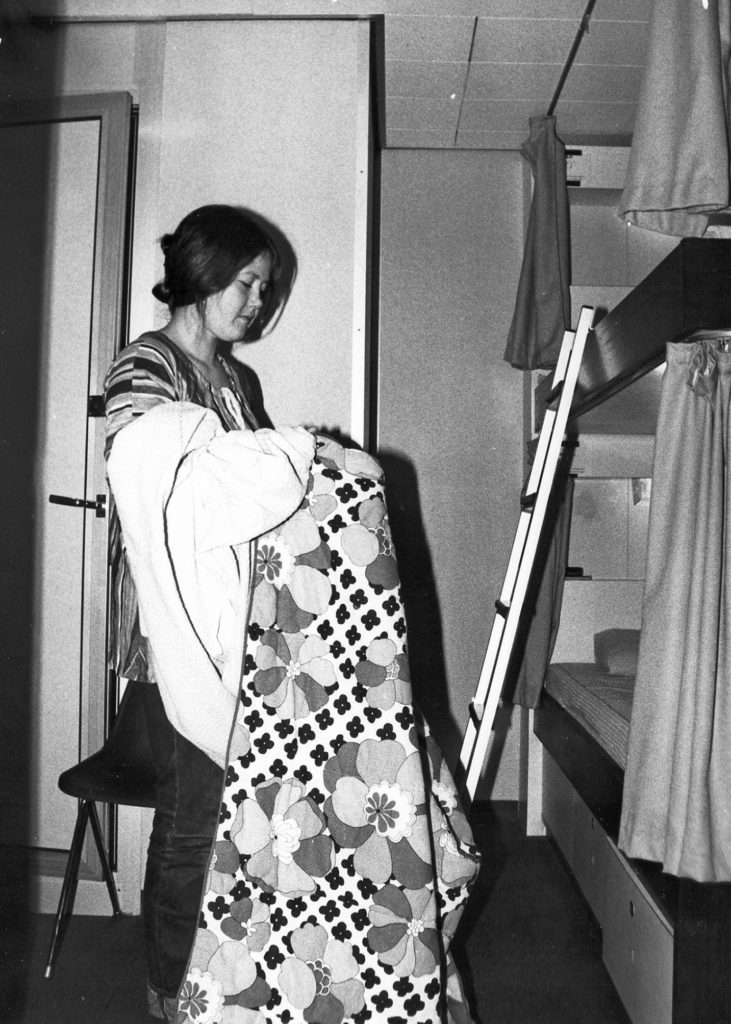Catering

Steward
 arbeidsliv, forpleining,
arbeidsliv, forpleining,The steward was in charge of catering services, and responsible for planning and coordination. Their working day ran from 08.00 to 20.00, and began at a coffee meeting with the staff – both those who were coming off the night shift and those starting the day shift. Reports were given about incidents during the night, and the day’s work was planned. The rest of the steward’s time was devoted to devising menus, checking stocks and ordering provisions as well as various administrative duties. The steward had to keep a constant check on supplies, so that new orders could be placed in good time. In the final years, the steward also assisted in the kitchen up to lunchtime.
“There was a lot of good food on Frigg,” reports steward Erling Hellesund, who joined the field for the first time in 1977. “Other things which affected the daily round were welfare days, which were organised on average once a fortnight. They included bingo and games evenings, or entertainers who were flown in from land.”
“It was the nurses who took proposed and organised these events, in cooperation with the catering team. We often served something extra then, such as canapés and champagne or cheese and red wine – always non-alcoholic. Christmas and 17 May [Norway’s Constitution Day] were celebrated with special menus.”
Many parties were held on Frigg in the early years. The management invited the bosses from Paris, politicians and other prominent guests. On such occasions, it was important that everything went well. The steward planned the reception in cooperation with management on land, producing menu options for the people ashore to select the one they thought most suitable. They also decided the layout of tables in the mess, which were laid with cutlery borrowed from the Atlantic Hotel in Stavanger. Place cards were usually employed. The menu and place cards were printed on land and sent out. Ahead of such a visit, the steward and the catering assistants practised waiting and how they should move the tables as quickly and neatly as possible into the positions specified by management. Those who would be waiting on the guests donned nice clothes.
Until the end of the 1980s, the catering department also ran a bar in the recreation room on the upper deck. It was open from 16.00 to 04.00, serving coffee, mineral water, and non-alcoholic beer and wine. Alcoholic beverages were not available. The catering department also managed a small shop, where a number of the items were sold duty-free because the field straddles the UK-Norwegian boundary. Cigarettes, in particular, were cheap. The duty-free section of the shop was closed towards the end of the field’s producing life.
When new supplies arrived, the catering staff organised their stowage in the freezer room and the dry food store.
Cooks
 arbeidsliv, forpleining,
arbeidsliv, forpleining,Weight was given to serving good food on Frigg, prepared by its own cooks. During the first few years, there were two cooks on the day shift and one at night. Two were French, recruited by SHRN of Marseilles, which was the parent company of Norske Chalk. As the number of employees on the field declined, kitchen staffing was reduced to one cook during the day and another at night. In the final years, the kitchen was staffed only during the day. Additional cooks came out during periods of intensive work when additional personnel were present – especially tie-ins of new fields and other work campaigns. Emphasis was given to preparing food properly, and avoiding part-cooked materials. Bread was baked on Frigg right up to the time the installations were removed, for instance.
Catering assistants
The steward had a staff of catering assistants, who worked in the mess by putting out food and laying tables and who were responsible for cleaning cabins and public areas. In addition, efforts were made to have a person who dealt with more thorough cleaning, such as polishing, washing carpets and waxing floors. The catering assistants were also required to ensure that everything was clean and pleasant in the day room and cinema.
During the early production years, the catering assistants were responsible for the bar and for showing cinema films. The latter job ended when TV was introduced to all the cabins, and a shelf of videos provided for self-projection in the cinema.
 arbeidsliv, forpleining,
arbeidsliv, forpleining,Målfrid Låte worked as a catering assistant on both Ekofisk and Frigg, although she prefers the title “cleaning lady” for her job. “I regularly worked the shift from 16.00 to 04.00,” she recalls from her time on Frigg. “This meant I had to wash offices and the like, before serving coffee and tea in the bar. It was a light job physically. I ran films for the operators from 00.30 to 02.30. But occasionally they told me not to show a film, but sit and talk with them for two hours. So I had to do that.”
During the day, the cabins with associated bathrooms were washed and the beds made. Tables had to be cleared after meals and the washing-up done. The kitchen and mess were also washed. The night shift cleaned the offices as well as doing the laundry. Beddings, towels, work clothes and personal garments were laundered. Midnight snacks were put out, and the washing-up done afterwards.
